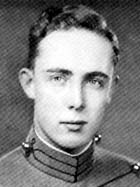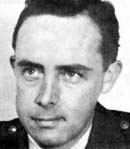Courtesy of His Classmates
United States Military Academy Class Of 1943
Barton Kyle Yount, Jr.
No. 13349 • 21 June 1919 – 25 February 1969
Died at Torrejon Air Base, Spain, aged 49 years
Interment: Arlington National Cemetery, Arlington, Virginia
Barton Kyle Yount, Jr. was born in San Diego, California, on 21 June 1919, the son of Mildred and Barton K. Yount, Sr. His early days were spent at various Army Air Corps bases, where he developed a deep respect for his country and the military services. His mother and father were pioneers in the Army Air Corps, later the Air Force. His father developed the largest Air Force Training Command during World War II. His mother was instrumental in the selection and adoption of the Air Force song. Bart was determined to follow in his father’s footsteps, and he studied his way into the Academy via Millard Preparatory School. He had the usual difficult plebe year, perhaps gaining a little extra upper class visibility due to his prominent military family. However, his dogged determination never allowed him to falter in his desire to graduate from the Academy. He was an outstanding golfer and played on the West Point Team from plebe year onward.
In addition to his golf, Bart was known for his beautiful dates. He was always extremely generous with his classmates and could be counted on to share his wide circle of acquaintances.
Bart applied himself well to academics and never had any real trouble with his grades. He would always help a classmate, when asked, in those subjects in which he did well.
When World War II broke out, Bart existed on rumors of early graduation. He was eager to get out into the thick of things. After completing basic flying training his first class summer, he looked forward to graduation in January 1943 so he could do his part instead of just studying for the part. In early 1943, after completing advanced training at Sumpter, South Carolina, he married Lucy Hampton Haskell Barriger before going on to B-29 transition. Bart and Lucy had two fine sons, Barton and Victor.
During World War II, Bart flew thirty B-29 missions from the Marianas. He participated in the first B-29 mission over Japan. From the 9th to the 15th of March 1945, Tokyo, Nagoya, Osaka, and Kobe were all attacked. Details of his heroic actions in the attack on Tokyo were printed in Newsweek magazine, and he received the Distinguished Flying Cross for these missions.
Bart’s first Oak Leaf Cluster to the Distinguished Flying Cross was received for action on 15 February 1945 for the following cited action:
“Adverse weather conditions made squadron assembly impossible, and most of the aircraft selected the target of opportunity (secondary target); however, Lieutenant Yount was determined to accomplish his assigned mission, and he attacked the primary target alone. Despite heavy fighter opposition he successfully bombed the primary target, the Mitsubishi Aircraft Engine Works at Nagoya.”
On his thirtieth mission in June 1945, Bart’s aircraft lost two engines and all four bomb bay doors malfunctioned. He had to ditch the aircraft with bomb bay doors open into a sea of swells from seven to ten feet high. This feat was accomplished so successfully that all twelve occupants of the aircraft escaped. After the ditching, he demonstrated exceptional leadership by personal example, establishing a system of rationing and assuring that injured crewmen were looked after and made comfortable on the overcrowded raft. Not mentioned in the citation was the fact that Bart returned to the sinking aircraft to get another raft that failed to jettison with full knowledge that should the aircraft sink he would be sucked down with the sinking B-29. For this heroic action Bart received his second oak leaf cluster to the Distinguished Flying Cross. Thereafter he was medically evacuated to the United States as his ear drums had burst during the descent for ditching.
After the war, Bart graduated from Georgetown University Law School and received an LLB degree in 1950. He was admitted to the DC Bar in 1951. During the early 1950s, he served in the Office of the Secretary of the Air Force.
After his Pentagon duty, he served in Spain as Chief, Plans and Negotiations Division, Joint United States Military Group, from 1953 to 1958. He was responsible for drafting and negotiating twenty procedural agreements with the Spanish Authorities concerning base rights in that country. He capably projected the need for U.S. economic/military assistance in Spain, the timing of the construction of facilities, and the areas where technical agreements were needed to spell out the coordination of United States Activities and those of the host country. Bart was personable, calm, and tactful in his dealings with Spanish officials, and, together with his wife Lucy, won the esteem of the Spanish associates as genuine Americans interested in the well-being and progress of all free people. He was awarded the Legion of Merit for this service.
In 1963, after another tour in the Pentagon where he served in both the Offices of the Secretaries of the Air Force and Defense, Bart returned to Spain for the second time at the request of the Chief Joint United States Military Command. His wise counsel and guidance were instrumental in negotiating the Status of Forces Agreement between the United States and Spain.
Bart retired after a meningitis attack in 1967 and made his home in Spain. While organizing a Spanish feeder airline, he was again stricken by meningitis. The loan for the airline was approved. However, Bart never recovered, it being God’s will that his contributions to his family, Air Force, and country be concluded here on earth.
His stone reads:
BARTON K. YOUNT, JR.
CALIFORNIA
COL
US AIR FORCE
WORLD WAR II
KOREA
VIETNAM
JUN 21, 1919
FEB 25, 1969
DFC – LM
AM & PH
Michael Robert Patterson was born in Arlington and is the son of a former officer of the US Army. So it was no wonder that sooner or later his interests drew him to American history and especially to American military history. Many of his articles can be found on renowned portals like the New York Times, Washingtonpost or Wikipedia.
Reviewed by: Michael Howard


